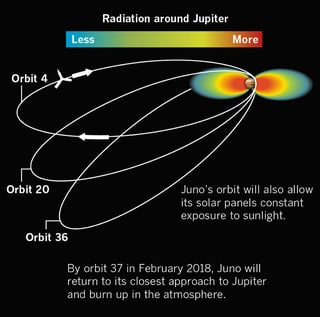The Juno Spacecraft (also Wikipedia, launch 05-Aug-2011, Jupiter orbit insertion 05-Jul-2016) was scheduled for a burn to reduce it's period from about 54 days to 14 days, while maintaining a similarly challenging low altitude periJove of only 4000 km above the planet's equator. Among the technical challenges are the intense radiation near Jupiter due to particles trapped in the planet's strong magnetic field. This lead to some extreme measures, including the 1 cm thick Tantalum Juno Radiation Vault to protect roughy 200 kg of electronic equipment.
It completed it's first periJove on 27-Aug-2016, and on the second periJove it was scheduled to execute the orbit reducing burn on 19-Oct-2016. Due to potential issues with the propulsion system discovered in telemetry prior to the scheduled burn, it was postponed. The burn was not executed during any subsequent burn, and now it seems the decision has been made to leave Juno in the longer orbit for the duration of the mission, according to Space Daily's Juno to remain in current orbit at Jupiter.
The article says:
Juno's larger 53-day orbit allows for "bonus science" that wasn't part of the original mission design. Juno will further explore the far reaches of the Jovian magnetosphere - the region of space dominated by Jupiter's magnetic field - including the far magnetotail, the southern magnetosphere, and the magnetospheric boundary region called the magnetopause. Understanding magnetospheres and how they interact with the solar wind are key science goals of NASA's Heliophysics Science Division.
"Another key advantage of the longer orbit is that Juno will spend less time within the strong radiation belts on each orbit," said Scott Bolton, Juno principal investigator from Southwest Research Institute in San Antonio. "This is significant because radiation has been the main life-limiting factor for Juno."
Question: What was the purpose of the planned change from 53 days to 14 days? Considering the advantages of staying in the longer orbit, what were the even more compelling advantages of the short orbit?
below: Plot of Juno's originally planned orbit from historical kernels (source and plot described here)in the JPL Horizions database. Juno remains in a single plane but with a reduced apoJove, The in-plane precession of the apses is due to Jupiter's substantial oblateness and large $J_2$. Left: projection into J2000 Ecliptic YZ plane. Right: XZ plane, coincidentally it is edge-on in this view due to mission schedule relative to Jupiter's orbit.
above: sketch of a few of Juno's lower 14-day orbits and illustration of the strongest radiation bands near Jupiter. From the Los Angeles Times
above: "Animation of Jupiter's Synchrotron Radiation Torus. Credit: NASA/JPL - Caltech". From the Vatican Observatory Blog


